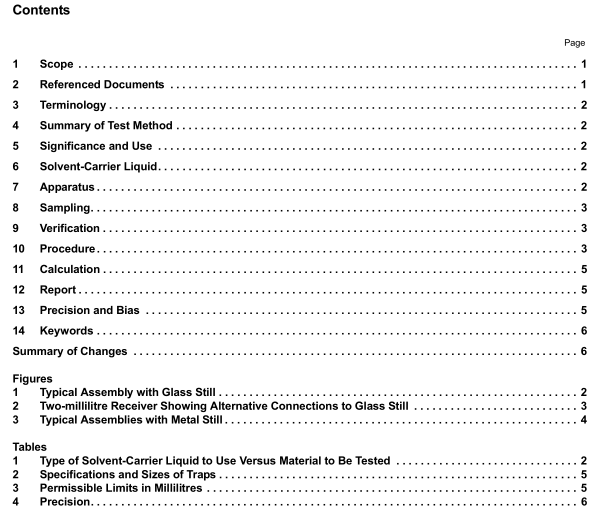API MPMS 10.5 pdf download

API MPMS 10.5 pdf download Manual of Petroleum Measurement Standards Chapter 10.5 Standard Test Method for Water in Petroleum Products and Bituminous Materials by Distillation
7.3 Heater—A suitable gas burner or electric heater may be used with the glass still. A gas ring burner with ports on the inside circumference shall be used with the metal still. The gas ring burner shall be of such dimensions that it may be moved up and down the vessel when testing materials that are likely to foam or solidify in the still.
7.4 Glassware—Dimensions and descriptions of typical glassware for use in this test method are provided in Specification E123. N OTE 5—Instead of standardizing on a particular apparatus specification with respect to dimensions and style, a given apparatus will be deemed satisfactory when accurate results are obtained by the standard addition technique described in Section 9.
8. Sampling
8.1 Sampling is defined as all steps required to obtain an aliquot ofthe contents ofany pipe, tank, or other system and to place the sample into the laboratory test container. Only representative samples obtained as specified in Practices D4057 (API MPMS Chapter 8.1) and D4177 (API MPMS Chapter 8.2) shall be used for this test method. 8.2 The size of the test portion should be based on the expected water content of the sample, such that the water yield does not exceed the capacity of the trap (unless a trap with a stopcock is used permitting excess water to be withdrawn into a graduated cylinder). 8.3 Practice D5854 (API MPMS Chapter 8.3) contains information on sampling and homogenization efficiency of unknown mixers. This test method should not be followed without strict adherence to Practice D5854 (API MPMS Chapter 8.3).
9. Verification
9.1 The accuracy of the graduation marks on the trap shall be certified or verified, using only national or international standards, such as National Institute of Standards and Technol- ogy (NIST) 4 traceable equipment. Verification shall be with a traceable 5 mL Micro Burette or Micro Pipette, readable to the nearest 0.01 mL.
9.1.1 In styles A, B, C, and D, as specified in Table 2 (Table 1 in Specification E123), each subdivision (that is, 0.1 mL through 1.0 mL) in the conical portion of the tube shall be verified. Thereafter, each major subdivision (that is, 2.0 mL, 3.0 mL, 4.0 mL, and up to the total volume ofthe trap) shall be verified.
9.1.2 In styles E and F, as specified in Table 2, each major subdivision (0.1 mL, 1.0 mL, 2.0 mL, 4.0 mL, and 5.0 mL in the case of Style E; 0.05 mL, 0.5 mL, 1.0 mL, 1.5 mL, and 2.0 mL in the case of Style F) shall be verified.
9.2 The entire glassware assembly shall be verified prior to first use and at a regular frequency thereafter as follows.
9.2.1 Put 400 mL ofdry (0.02 % water maximum) xylene or the solvent to be utilized in the analysis of unknown samples into the apparatus and test in accordance with Section 10. When complete, discard the contents of the trap and add the volume of water as specified as first test in Table 3 directly to the distillation flask and test in accordance with Section 10.
9.2.2 Repeat the test in 9.2.1, and add the volume specified as second test in Table 3 directly to the flask. The assembly of the apparatus is satisfactory only if the trap readings are within the tolerances specified in Table 3.
9.3 A reading outside the permissible limits suggests a malfunction resulting from vapor leaks, too rapid boiling, inaccuracies in calibration of the trap, or ingress of extraneous moisture. Eliminate these factors before repeating the verification.
10. Procedure NOTE 6—The precision of this test method will be affected by water droplets adhering to surfaces in the apparatus and therefore not settling into the water trap to be measured. To minimize the problem, all apparatus must be cleaned chemically at least daily to remove surface films and debris, which hinder free drainage of water in the test apparatus. More frequent cleaning is recommended if the nature of samples being run causes persistent contamination.
10.1 Measure a suitable amount of sample to an accuracy of 6 1% and transfer it to the still.









